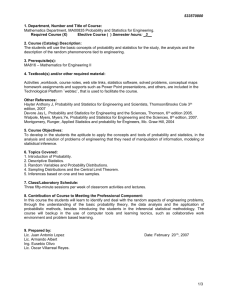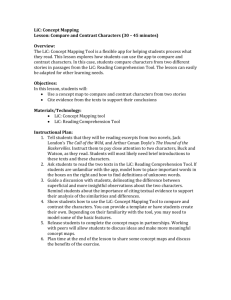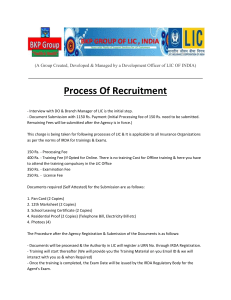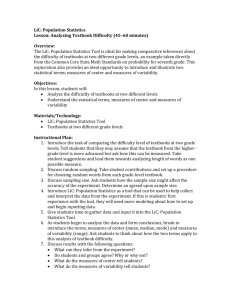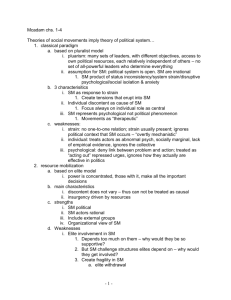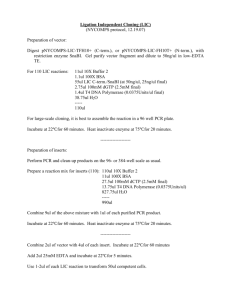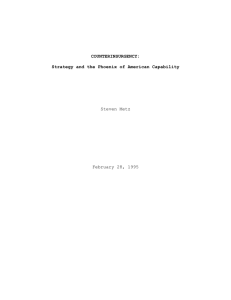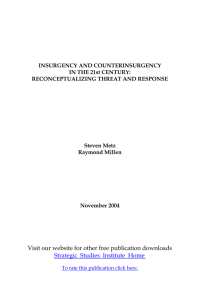THE FUNDAMENTALS OF LOW-INTENSITY CONFLICT CHAPTER 1
advertisement
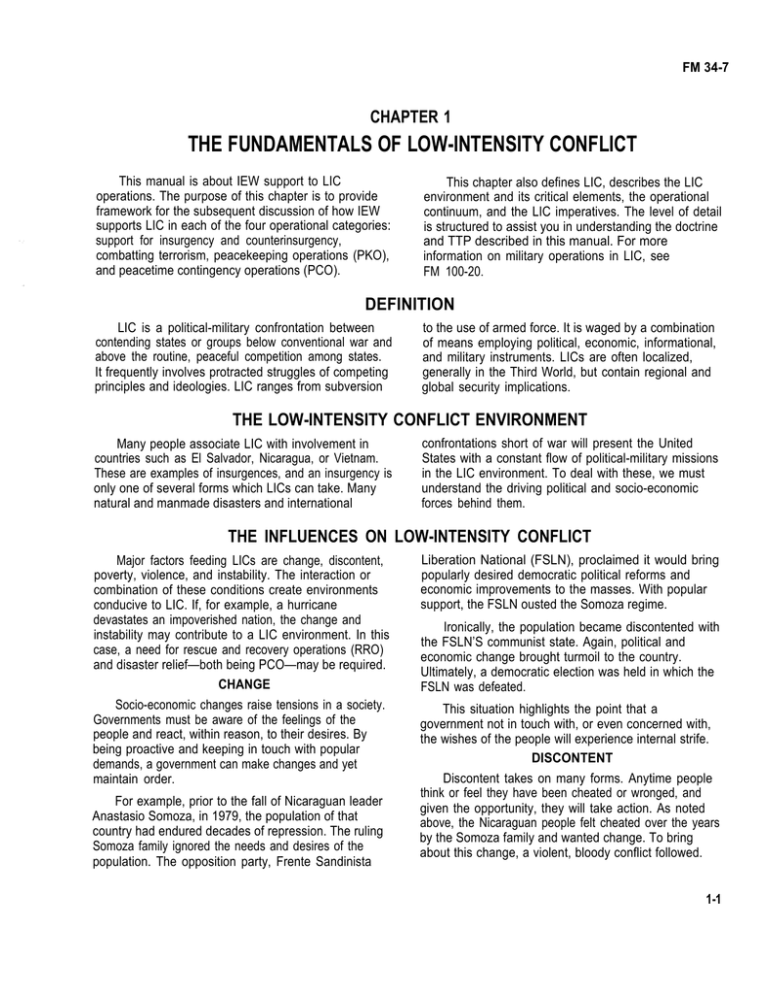
FM 34-7 CHAPTER 1 THE FUNDAMENTALS OF LOW-INTENSITY CONFLICT This manual is about IEW support to LIC operations. The purpose of this chapter is to provide framework for the subsequent discussion of how IEW supports LIC in each of the four operational categories: support for insurgency and counterinsurgency, combatting terrorism, peacekeeping operations (PKO), and peacetime contingency operations (PCO). This chapter also defines LIC, describes the LIC environment and its critical elements, the operational continuum, and the LIC imperatives. The level of detail is structured to assist you in understanding the doctrine and TTP described in this manual. For more information on military operations in LIC, see FM 100-20. DEFINITION LIC is a political-military confrontation between contending states or groups below conventional war and above the routine, peaceful competition among states. It frequently involves protracted struggles of competing principles and ideologies. LIC ranges from subversion to the use of armed force. It is waged by a combination of means employing political, economic, informational, and military instruments. LICs are often localized, generally in the Third World, but contain regional and global security implications. THE LOW-INTENSITY CONFLICT ENVIRONMENT Many people associate LIC with involvement in countries such as El Salvador, Nicaragua, or Vietnam. These are examples of insurgences, and an insurgency is only one of several forms which LICs can take. Many natural and manmade disasters and international confrontations short of war will present the United States with a constant flow of political-military missions in the LIC environment. To deal with these, we must understand the driving political and socio-economic forces behind them. THE INFLUENCES ON LOW-INTENSITY CONFLICT Major factors feeding LICs are change, discontent, poverty, violence, and instability. The interaction or combination of these conditions create environments conducive to LIC. If, for example, a hurricane devastates an impoverished nation, the change and instability may contribute to a LIC environment. In this case, a need for rescue and recovery operations (RRO) and disaster relief—both being PCO—may be required. CHANGE Liberation National (FSLN), proclaimed it would bring popularly desired democratic political reforms and economic improvements to the masses. With popular support, the FSLN ousted the Somoza regime. Socio-economic changes raise tensions in a society. Governments must be aware of the feelings of the people and react, within reason, to their desires. By being proactive and keeping in touch with popular demands, a government can make changes and yet maintain order. This situation highlights the point that a government not in touch with, or even concerned with, the wishes of the people will experience internal strife. DISCONTENT Discontent takes on many forms. Anytime people think or feel they have been cheated or wronged, and given the opportunity, they will take action. As noted above, the Nicaraguan people felt cheated over the years by the Somoza family and wanted change. To bring about this change, a violent, bloody conflict followed. For example, prior to the fall of Nicaraguan leader Anastasio Somoza, in 1979, the population of that country had endured decades of repression. The ruling Somoza family ignored the needs and desires of the population. The opposition party, Frente Sandinista Ironically, the population became discontented with the FSLN’S communist state. Again, political and economic change brought turmoil to the country. Ultimately, a democratic election was held in which the FSLN was defeated. 1-1 FM 34-7 Not all forms of discontent will be violent, The amount of perceived injustice often determines the level of discontent. The critical factor influencing the level of discontent is the number of people with the same feeling or the impact of outside pressure. For example, the people of Panama were unhappy for years with General Manuel Noriega’s stranglehold on their country, yet they did not have enough support to overthrow him. For nearly two years a sector of the Panamanian people openly, but mildly, opposed Noriega. It was only with US intervention and assistance that they were able to rid themselves of him. POVERTY As mentioned before, poverty or unstable economic conditions are influencing factors on LIC. Impoverished nations are ripe for change and revolution. The masses are anxious for an improved standard of living. The smart revolutionary leader determines what the populace wants from economic change. He will not second guess nor attempt to read their minds and force unwanted reforms. Typically, the populace desires only what they consider to be their fair share: a few more hectares of land perhaps. It is easy for the revolutionary to promise such things and gain the popular support of the people. Consider the labor movement led by Lech Walesa in Poland a few years ago. While some violence was encountered through demonstrations; economic advances, labor reforms, and ultimately freedom were accomplished. VIOLENCE The danger of violence is a dominant force in any LIC mission. Do not consider the threat as the only source of violence. You may encounter a repressive host nation (HN) or third-party country that engages in violence against its detractors as well as its own population. The violence created by a natural disaster combined with the HN lack of humanitarian relief (by intent or lack of resources) also will be a negative force. Violence produces instability. INSTABILITY Instability within the general population, the military, or the government of a nation develops from any or all of the preceding forces. Instability, a force in any LIC mission, is not always bad. Consider instability created by a counterinsurgency operation. The insurgency element will consider . instability an asset; the HN will not. The Somoza regime in Nicaragua did not like the instability created by the FSLN. The FSLN, however, relished the inactivity of the Somoza regime following the earthquake of 1972 because they mobilized the impoverished, disaster-stricken populace to revolt. THE IMPERATIVES OF LOW-INTENSITY CONFLICT The following five imperatives are common to each LIC category. Success in LIC requires the use of these as a checklist in your mission planning stage. POLITICAL DOMINANCE Civil authority and political objectives drive military decisions at every level. These political objectives must be understood as they affect military operations and influence selected courses of action (COAs). Civil authority must adopt COAs that legally support those objectives even if the COAs appear to be outside the traditional miIitary doctrine. UNITY OF EFFORT Consider how military actions integrate with, and contribute to, initiatives of other government agencies. Interagency coordination is critical. Commanders may answer to civilian chiefs or employ the resources of civilian agencies. 1-2 ADAPTABILITY This is the skill and willingness to change or modify structures and methods to meet different situations. Adaptability is more than merely tailoring or the built-in flexibility of common techniques and organizations. It means developing new ones appropriate to each situation. LEGITIMACY Legitimacy stems from the willing acceptance by the governed of the right of the government to rule. It comes from the belief that authority is genuine and effective and uses the proper agencies for reasonable purposes. Legitimacy is the central concern of all parties involved in a conflict. FM 34-7 PERSEVERANCE LIC, by nature, typically involves protracted struggles. Perseverance requires careful, informed analysis to select the right time and place for decisive action. Perseverance is the patient, resolute and persistent pursuit of goals and objectives for as long as it takes to achieve them. OPERATIONAL CATEGORIES US military operations in LIC faI1 into four broad categories. They are— • Support for insurgency and counterinsurgency. • Combatting terrorism. • PKO. • PCO. LIC operations may involve one or more of these categories. Understanding the similarities and differences between the operational categories helps establish priorities in actual situations. SUPPORT FOR INSURGENCY AND COUNTERINSURGENCY US security interests may lie with an incumbent government or with an insurgency. Both insurgences and counterinsurgencies concern themselves with mobilizing the support of the people. How they distribute their efforts between building support for themselves and undermining the support and legitimacy of their opponents is the central dilemma for both insurgents and counterinsurgents. This point is highlighted by the situation in El Salvador leading up to the cease-fire implemented 1 February 1992. The opposition force, Frente Farabundo Marti de 1a Liberation National (FMLN), tried to build support for itself with the population while at the same time discrediting the government. his was a difficult task, as the FMLN did not want to discredit itself by conducting actions against the government that offended the populace. Insurgency An insurgency is an organized and armed political struggle, the goal of which maybe to seize power through revolutionary takeover and replace the existing government. In some cases insurgency goals maybe more limited. For example, the insurgency may intend to breakaway from government control and establish an autonomous state within traditional ethnic or religious territorial bounds. The insurgency may also only intend to extract limited political concessions unattainable through less violent means. There are seven elements common to all insurgences: Leadership. Ideology. Objectives Environment and geography. External support. Phasing and timing. Organizational and operational patterns. These elements provide a framework for analysis which can reveal the insurgency’s strengths and weaknesses. Although you examine them separately, you must understand their interaction to fully understand the insurgency. Chapter 5 and FM 100-20, Appendix C, explain this fully. The US supports selected insurgences opposing oppressive regimes working against US interests. We coordinate this support with our friends and allies. Feasibility of effective support and the compatibility of US and insurgent interests are major considerations. Support for insurgency is often covert, and many of the operations connected with it are special activities. Special operations forces (SOF) are well-suited to provide this support because of their extensive unconventional warfare (UW) training. General purpose forces may be called upon when the situation requires their functional specialties. Their tasks may include support and advice. Command and control (C2) relationships are normally situationSpecific. When ordered, US armed forces provide equipment, training, and services to the insurgent force. Types of operations in which US forces can assist insurgents include— • Recruiting, organizing, training, and equipping forces to perform UW or guerilla warfare. • Psychological operations (PSYOP). 1-3 FM 34-7 Institution and infrastructure development. Intelligence gathering. Surreptitious insertions. Linkups. Evasion and escape of combatants. Subversion. Sabotage. Resupply operations. Counterinsurgency Counterinsurgency is all military, political, economic, psychological, and civic actions taken by a government focused on defeating an insurgency. It can provide guidance for the organization and conduct security force operations based on the HN internal defense and development (IDAD) strategy. A nation’s IDAD strategy is the full range of measures taken by them to promote their growth and to protect themselves from subversion, lawlessness, and insurgency. It focuses on building viable political, economic, military, and social institutions that respond to the needs of society. Its fundamental goal is to prevent insurgency. It does this by forestalling and defeating the danger from insurgent organizations, and at the same time working to correct those conditions that foster instability. The government mobilizes the population to participate in IDAD efforts. IDAD is, ideally, a preemptive strategy against insurgency. However, if the insurgency develops, it provides a framework for counterinsurgency activities. The IDAD concept uses all the leadership, organizational, and material resources available to the HN. The HN identifies the real or imagined grievances of its people and takes political, economic, and social actions to redress them. It acts in an orderly way within its constitutional system. The actions it takes should gain popular support for the HN and forestall insurgent efforts. HN security forces (military, paramilitary, and police) defeat insurgent combat elements, neutralize their leadership, and establish a peaceful environment in which social progress develops. The HN cannot depend upon outside combat forces to wage their battles for them. HN security forces support the development effort through civil-military 1-4 operations conducted in accordance with the HN IDAD plan. The US uses its military resources to support HN counterinsurgency operations under a foreign internal defense (FID) agreement. FID is the participation by civilian and military agencies of one country in any of the action programs another government takes to free and protect its society from subversion, lawlessness, and insurgency. The US ambassador, through his country team, provides the focal point for interagency coordination and supervision of FID. Military support to FID is provided through the unified Commander in Chief (CINC). The US conducts FID operations in accordance with the HN’s IDAD concept. The US may provide materiel, advisors, trainers, and security assistance forces to support the HN counterinsurgency operations through the security assistance office (SAO). More direct forms of support may be provided when required, such as advisors and trainers and FID augmentation force. The US provides support to counterinsurgency based on a National Command Authorities (NCA) decision. US support to HN counterinsurgency programs is a balanced effort of both civil and military support. The principal US role is to augment security assistance programs by providing military training, technical training, and intelligence and logistical support. The objective of military involvement is to- • Improve the efficiency of the supported security force and its military operations. • Help stop external support to the insurgency. • Augment other US government agency efforts. • US forces activities in support of HNs that conduct counterinsurgency include— Intelligence operations. Joint-combined command post (CP) exercises. Civil-military operations, including civil affairs (CA) and PSYOP. Humanitarian or civic assistance. Logistical support. Populace and resources control. Counter-drug operations. Tactical operations. FM 34-7 COMBATTING TERRORISM Terrorism is the calculated use of violence or threat of violence to inculcate fear; it is intended to coerce or intimidate governments or societies in the pursuit of goals that are generally political, religious, or ideological. It is often difficult to distinguish the acts of politically motivated terrorists from acts performed by criminals. Criminal acts create similar tactical problems for security forces, but normally have no political intent nor effect. Some criminal organizations, especially drug traffickers, have become powerful enough to have broad political interests. When they pursue these interests by terrorism, they become a military concern like any other political terrorist group. The terrorist neither needs nor necessarily wants popular support. Terrorist organizations and movements require secrecy. Their activities do not conform to rules of law or warfare. Their victims are frequently innocent bystanders, or symbolic persons and places, and usually have no role in either causing or correcting the terrorist’s grievance. Terrorist acts include threats of (or actual) hostage taking, hijacking, sabotage, assassination, arson, hoaxes, bombings, and armed attack. The aim of combatting terrorism is to protect innocent lives and property. Combatting terrorism includes both antiterrorism (AT) and counterterrorism (CT) actions throughout the entire continuum of military operations. The combatting terrorism program is designed to provide coordinated action before, during, and after terrorist incidents. Antiterrorism AT involves all measures taken by installations, units, or individuals to reduce the probability of their falling victim to terrorist acts. Educational programs, physical security, personal protection techniques, and operational patterns are all examples of making a target less appealing to a terrorist. Announcing military police (MP) searches of cars entering installations and the hardening of facilities by using fences, walls, and other protective devices are forms of AT. Counterterrorism CT is the full range of offensive measures to prevent, deter, and respond to terrorism. Participation in CT actions is normally limited to specially trained and equipped forces kept on alert status for that purpose. One example of this is the Israeli operation to rescue the airline passengers held hostage in Entebbe, Uganda, in 1976. PEACEKEEPING OPERATIONS PKO are military operations conducted with the consent of the belligerent parties to a conflict to maintain a negotiated truce and to facilitate a diplomatic resolution. The US may participate in PKO under the auspices of an international organization, in cooperation with other countries, or unilaterally. PKO support diplomatic efforts to achieve, restore, or maintain the peace in areas of potential or actual conflict. PKO include— • Withdrawal and disengagement. • Cease-fire. • Prisoner-of-war exchange. • Arms control. • Demilitarization and demobilization. When an operation is approved, Department of Defense (DOD) designates a service to be executive agent for the specific operation. The executive agent provides administrative personnel, together with operational and logistic support. It also provides command, control, and communications (C3) support for committed US military forces. It may also assist forces of other nations when in accord with diplomatic agreement. The three key administrative documents used to address problems the force will face are discussed below. Terms of Reference (TOR) The TOR, similar to an operations order (OPORD), is published by the executive agent. It describes how the US will implement its portion of the operation. The TOR, which maybe subject to approval by each party to the dispute, describes— The mission. Command relationships. Organization. Logistics support. Accounting procedures. Responsibilities of the US contingent to the peacekeeping force. Coordination and liaison arrangements. 1-5 FM 34-7 Your force will operate strictly within the parameters of its TOR, doing neither more nor less than it mandates. A distinguishing feature of these operations is that the peacekeeping force normally is forbidden to use violence to accomplish its mission. In most cases, it can use force only for selfdefense. The multinational force and observers in the Sinai region are examples of this type of mission. Letter of Instruction (LOI) LOIs are prepared by the major organization tasked with providing units and elements of the US peacekeeping force contingent. LOIs amplify information contained in the TOR. Each LOI contains information on— Shows of force and demonstrations. Noncombatant evacuation operations (NEO). RRO. Strikes and raids. Peacemaking. Uw. Disaster relief operations (DRO). Organization and equipment. Counter-drug operations. Operations. Security assistance surges (SAS). Intelligence. Support to US civil authorities. Personnel. Logistics. Communications-electronics (C-E). Public affairs. Finance. Air operations. Nuclear, biological, and chemical (NBC) defense. Command relationships. Area Handbooks You will directly produce area handbooks. They contain, at a minimum, information on— The peacekeeping organization. History and culture of the people. Terrain. Weather. Local armed forces. You may decide to include graphic information on the insignia, markings, and identifying characteristics of armed forces, military weapons, and equipment. PEACETIME CONTINGENCY OPERATIONS PCO are politically sensitive military operations normally characterized by short-term, rapid projection or employment of forces in conditions short of war. 1-6 They are often undertaken in crisis avoidance or crisis management situations requiring the use of military power to enforce or support diplomatic initiatives. PCO include, but are not limited to- Military efforts in PCO complement political and informational initiatives. This relationship distinguishes PCO from contingency operations in war, which are often conducted for purely military objectives. Clear command relationships and communications procedures must be established by agreement, because the lead organization varies according to the type of mission. Your understanding of& matters is necessary to ensure smooth coordination of the effort. PCO use tailored forces, are usually short in duration, and are joint or combined. Military forces employed in PCO will normally use service-specific tactical doctrine or joint tactics, techniques, and procedures (JTTP) in executing their mission. A basic tenet is to rapidly project military forces consistent with the factors of mission, enemy, terrain, troops, and time available (METT-T in order to bring the contingency to an immediate close under conditions favorable to the US. The forces employed will be chosen from designated contingency forces who have planned and trained for these types of operations. The time available will rarely allow any other forces to train to the required standard necessary for the successful conduct of the operation. As a result, it is your responsibility to have all current intelligence products and graphics on hand to support an operation. Mapping, charting, and geodesy (MC&G) products should also be on hand and in sufficient quantities to support your contingency. FM 34-7 The unifying feature of these disparate actions is the rapid mobilization of assets to focus on a specific problem. This usually is a crisis and guided at the national level. Frequently, these operations take place away from customary facilities, requiring deep penetration and temporary establishment of long lines of communication (LOC) in a threatening or hostile environment. PCO may require the exercise of restraint and the selective use of force or concentrated violent actions. A wide array of options for US force employment exists. Limited in duration and usually focused on a specific objective, they do not always require combat operations. Two examples follow • • Operation BLAST FURNACE was the 19S6 aviation task force support of the Bolivian Narcotics Police involving six UH-60 helicopters with an accompanying support security and intelligence package. The mission was to assist in targeting cocaine production laboratories and to transport HN security personnel to conduct raids. Operation HAWKEYE was the XVIII Airborne Corps Task Force deployment to the island of St. Croix to assist local law enforcement following hurricane Hugo in 1989. The task force (TF) included C3, MP, CA and medical personnel. THE CONTINUUM OF MILITARY OPERATIONS AND LOW-INTENSITY CONFLICT With these missions in mind, we can examine the continuum of military operations. This review highlights the possibility of your being involved in two or more missions at the same time. It also shows you the possibility of being involved in different levels of conflict at the same time. Routine peaceful competition is the normal desired end state of global interests. The states of the world pursue their own interests, sometimes in harmony, but with enough common interests to avoid violence. This is the relationship of nations, both internally and externally, during what is commonly referred to as peacetime. To preserve this peaceful environment and to achieve US goals, our military focuses on deterring war, but supports political, economic, and informational efforts. Figure 1-1 shows the continuum of military operations in LIC. Do not define boundaries between the categories when you view the continuum. This allows you to realize that you may have different levels of conflict at the same time. For example, in Vietnam conventional US forces were battling conventional North Vietnamese forces in one area, while at the same time US Special Forces were conducting UW and civic action in others. It is possible to jump across the continuum, either escalating or decreasing the scope of the conflict without stopping at intermediate points on the scale. It is likely that the cessation of hostilities at one level will not result in the resumption of routine peaceful engagement but in a move to some level of LIC. This was the case following the conclusion of the 1973 Arab-Israeli war, with the 1979 Camp David Accords resulting in the ongoing United Nations (UN) PKO in the Sinai. Within this continuum, the US can find itself in peacetime engagement with one nation, at war with another, and in hostilities short of war with still another nation—all at the same time. As PCO of the past decade reveal, the operational continuum is nonlinear. This permits operations to flow in all directions. This is a key point of the operational continuum: operations do not end after the cessation of hostilities-just as they do not begin with the firing of the first shot. 1-7 FM 34-7 I \ Figure 1-1. Continuum of military operations in LIC. 1-8 FM 34-7 THE LOW-INTENSITY CONFLICT CONTINUUM APPLIED The US and Iraq were in peacetime engagement following the Iran-Iraq war. The US was hoping to influence Baghdad and pull it out of the Soviet sphere. But in July 1990, Iraq massed troops on the Kuwaiti border and threatened to invade if Kuwait did not cut its oiI production. The US response was mostly in the diplomatic arena; however, we held joint air defense exercises with our Persian Gulf allies, which placed us on the brink of hostilities short of war. When Iraq appeared to back off, it looked as though the situation would revert to peacetime engagement. However, after Iraq’s invasion of Kuwait and the subsequent execution of Operation DESERT SHIELD, the US and Iraq entered into hostilities short of war. Had Operation DESERT SHIELD succeeded in convincing Iraq to withdraw from Kuwait, it would not have been necessary to move into the next environment of the continuum-War. However, after months of diplomatic and military maneuvering, the US and its allies initiated Operation DESERT STORM, and we crossed over into war. Initially, the allies limited their actions to aerial bombing hoping to persuade Iraq to withdraw. Again, it was Iraq’s failure to withdraw that forced the allies to move deeper into the war environment of the continuum with the initiation of ground operations. After the l00-hour ground war, the allies called a halt to offensive operations but maintained forces inside Iraq—thus moving back into hostilities short of war. Still within that area on the continuum, the situation with the Kurdish refugees in northern Iraq caused the US to initiate Operation PROVIDE COMFORT and Operation GALLANT PROVIDER. The ultimate allied goal is to work through the operational continuum while rebuilding Kuwait and Iraq, and to reestablish the environment of peacetime engagement. 1-9

